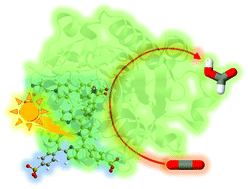Visible-light-driven CO2 reduction to formate with a system consisting of water-soluble zinc tetraphenylporphyrin tetrasulfonate (ZnTPPS), formate dehydrogenase from Candida boidinii (CbFDH) and 1-amino-1′-carbamoyl-4,4′-bipyridinium salt (ACBP) as an electron mediator in the presence of triethanolamine (TEOA) as an electron donor was investigated. ACBP was prepared as the 4,4′-bipyridinium salt with amino and carbamoyl groups to promote an improvement in affinity with CbFDH. The properties of ACBP were characterized by photochemical and electrochemical approaches. The affinity between the single-electron reduced ACBP (ACBP+˙) and CbFDH was estimated using simple docking simulation. It was speculated from the docking simulation that ACBP+˙ binds near the substrate binding pocket of CbFDH like NAD+. In visible-light-driven ACBP reduction with the sensitization of ZnTPPS in the presence of TEOA, with the reduction yield of ACBP to ACBP+˙ estimated to be over 95%. In CO2 reduction to formate with a system consisting of TEOA, ZnTPPS, ACBP and CbFDH, the turnover numbers of ACBP and CbFDH were estimated to be 0.17 and 15.2 h−1, respectively.

